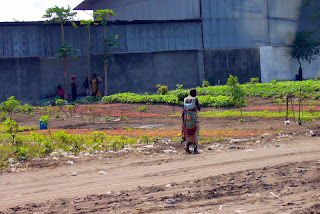The last week of August 2010 Ron and I rode from Johannesburg seven hours south across open countryside with our Salt Lake Security Manager and his wife to Durban, South Africa. Ron and I presented the mission president and office staff security training regarding missionaries and made assessments on the mission home and mission office for building security. In the afternoon the physical facilities manager of the Durban area guided us on a tour of a recently burned meetinghouse. As the men (Ron, SLC manager, physical facilities manager and contractor) discussed the evidence and possible causes, I took photos of the surrounding neighborhood. Their investigation concluded the cause was electrical rather than arson. We also presented a security briefing to two recently arrived Senior Missionary couples who are serving in Employment and at the Mission Office. That evening we presented training regarding priesthood stewardship of meetinghouses to 18 stake and ward brethren in one of the two stakes in Durban, the stake president conducting.
Across the street from the burned meetinghouse were two neighborhood gardens with women watering the individual plants by hand from buckets of water. This women then harvested a cabbage which is a staple for many people.

These four elders were serving in the mission office and attended our training. The two on the left we met at our security presentation in the MTC. It is always a treat to see "our" elders again, visit and have them assist us in training by sharing what they have experienced previous to and while on their missions regarding personal security.

On our return trip we drove north from Durban up the Indian Ocean coastline and stayed at St. Lucia. This is a quaint town about six blocks wide and long nestled between the ocean and an estuary which leads to an inland salt lake. In this tropical setting there are two notable inhabitants--crocodiles and hippos. At the mouth of the estuary we watched crocodiles close to shore. As evening set in we marveled at a daily sight of hippos grazing throughout the town! We waited at a four way stop sign for a hippo to meander across the road ahead of us, another crossed the road in front of us, and a third we watched from the lawn of our B&B with only a 2 1/2 foot high masonary wall and 10 yards of grass separating us. We learned hippos cannot step higher than 16 inches and can walk up to 30 km (about 15 miles) a night grazing. It was amazing seeing these mammoth animals up close. We have been told hippos kill more humans in Africa than any other animal so were careful to just quietly watch.
The next morning we took a tour boat up the estuary similar to the one pictured behind us along with hippos and a crocodile in the water--awesome. Along the shoreline we saw 12 crocodiles mostly by themselves, 64 hippos in pods of 3-20, a variety of African birds, Water Monitor lizards and Vervet monkeys scampering in the trees.

Leaving the wetlands for the dry mountains our next stop was iMfolozi Hluhluwe Nature Reserve. Here we saw warthogs, zebra, Nyala, Impala, Wildebeest, 21 rhinos, elephant herd on the hillside, 25 giraffe and over 100 Cape Buffalo. Being springtime, many babies were seen with their mothers. We thought the fuzzy tufts on this baby giraffe were charming. A Cape Buffalo poised right next to the road for us. Notice the bird on his face which we watched groom the buffalo's ears, nose and head. This was an awesome sighting.



















































